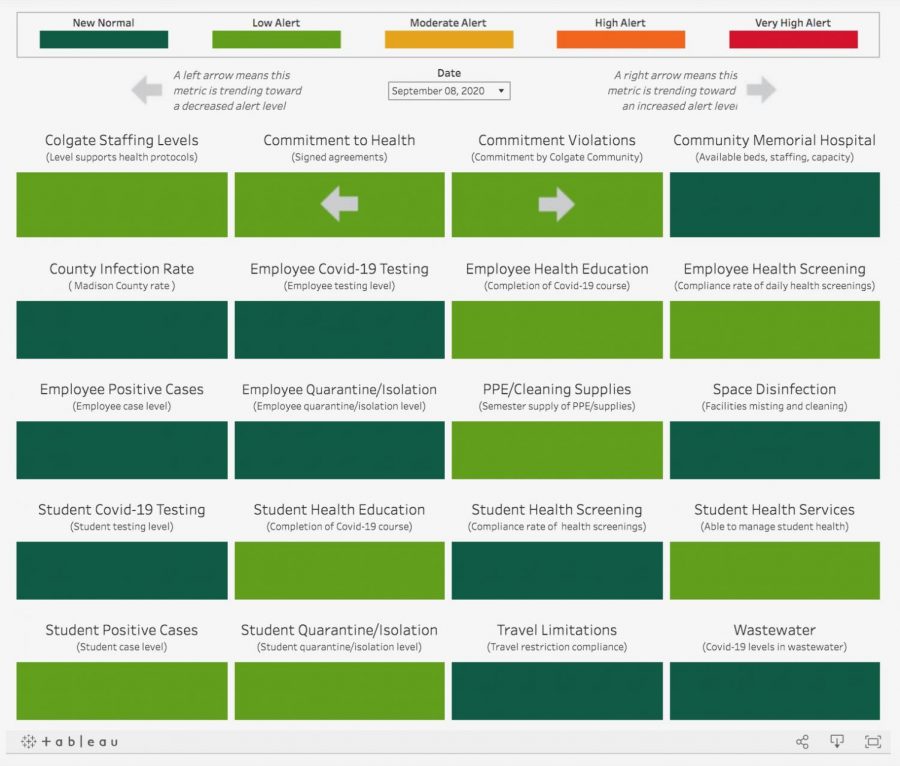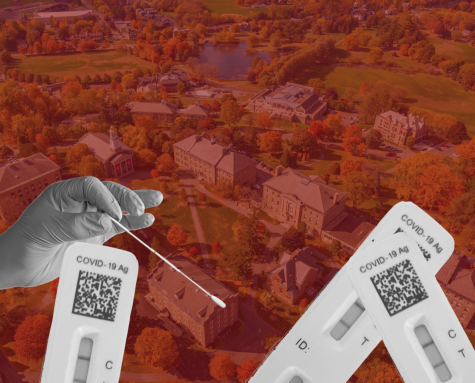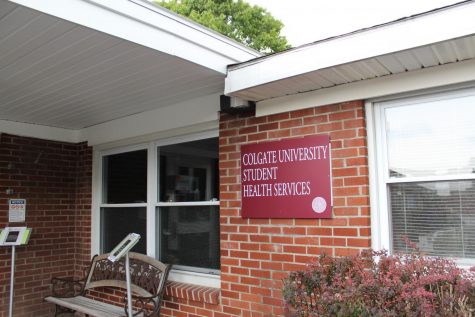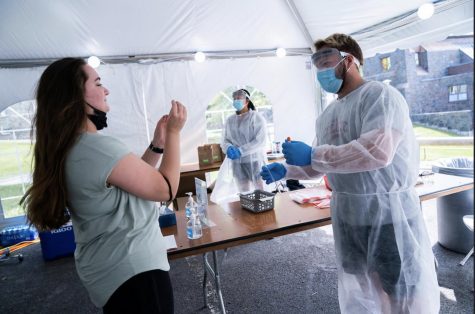Health Analytics Team Seeks To Keep Community Informed Through Online Dashboard
Since the University’s Health Analytics Team (HAT) publicly released the Health Analytics Dashboard with Colgate Metrics online, the web page has been viewed over 21,000 times as of Friday morning.
Formed as part of the Campus Reopening Plan by the Task Force on Reopening Colgate, the HAT consists of membership from across the University, including representatives from Campus Safety, Student Health Services, Environmental Health and Safety, Facilities Management, the Dean of the College and the Dean of the Faculty’s Office, IT, Human Resources and Athletics. According to the University’s website, the HAT “continuously evaluates numerous data points related to Colgate’s return to on-campus operations to ensure effective public health measures are in place.”
Financial Analyst and Health Analytics Manager Severin Flanigen said the main goal of the team is to monitor metrics that have been identified as critical to the health of the University and community and keep the public informed via metrics uploaded to the dashboard.
“We are talking about community health and not just what’s going on at Colgate University, so we wanted to provide as much information as we could without overloading people,” Flanigen said. “We met as a group and said, ‘Ok these are all the metrics that we’re looking at, what do we consider to be the key metrics in promoting community health,’ and that’s how we came up with 20 public-facing metrics.”
All of the 20 metrics are assessed from “New Normal” to “Very High Alert.” Employee Health Screening, one of the 20 metrics, had previously been on moderate alert since Aug. 27 but decreased to low alert on Sept. 4.
“Employees—that is faculty and staff [who] are on campus each day—are required to do a daily health screening before they come to work or immediately upon arriving to work. We know who everybody is and we check to make sure that the daily health screening was done. The reason for lowering it was that our compliance rate is up above 95 percent. We strive to reach 100 percent,” Flanigen said.
Email reminders are set to go out to staff who have not completed their daily health screening, and the HAT also built dashboards for supervisors to monitor individuals and put “more emphasis on… the supervisor and employee relationship” in an effort to raise compliance rates to 100 percent, according to Flanigen.
On Sept. 4, Colgate Staffing Levels and Student Quarantine/Isolation increased to moderate alert while all other categories stood at the new normal or low alert. Flanigen reported a rise in the number of students in quarantine on Thursday, Sept. 3, which caused the increase in alert for Student Quarantine/Isolation the following day. The alert level has since decreased to low alert as of Sunday, Sept. 6.
“The Health Analytics team has identified several departments within Colgate that we deemed critical to the day-to-day operations… In our discussions [on Sept. 4], there are some people that are out [and] that made us comfortable in raising that alert level to moderate,” Flanigen said about the increase in alert for Colgate staffing levels, which returned to low alert on Monday, Sept. 7.
In a campus-wide email sent Thursday, June 25, President Brian Casey specified that reopening campus at full capacity is “not without risk” and that new cases are expected, a possibility anticipated by the HAT.
“With students coming from literally all parts of the world to come into Colgate, we had no illusions that we wouldn’t have any positive cases, and so all over the summer we were preparing plans for what we would do when we have positive students,” Flanigen said. “It was just a matter of how many and could we handle the number of positives, and so far we have been able to do that successfully.”
On Tuesday, Sept. 8 Colgate transitioned to Gate 1 because health metrics remained at low levels during Gate 0 for the necessary minimum of 14 days. In Gate 1, small groups can gather and new activities can begin on and off campus. The HAT planned to meet with Casey and the Task Force on Reopening on Monday, Sept. 7 to make a recommendation based on the metrics as to whether the campus can proceed to Gate 1.
“Now we also, as the Health Analytics team, can make a recommendation at any point to the Task Force on Reopening, to the Emergency Operations Center [EOC] and to the President’s Cabinet based on the data we’re observing in our metrics, [which] could go up to and including a recommendation to close the campus. But that decision would be made by the president,” Flanigen said.
According to Media Relations Director Daniel DeVries, Colgate’s Office of Communications has six team members on the EOC, including himself. Although the Office of Communications does not directly work with the HAT, both are part of the EOC.
“I think if there was one piece [that drives our communications] it would be the EOC and the determinations of that group but the dashboard’s kind of like one piece … where it’s one part of our overall communications landscape,” DeVries said. “100 [percent] of our communications strategy is based off what is developed in the EOC and what the campus needs to know based on those decisions so you know our number one priority is trying to determine what is the most important thing for the community.”
Residing in the Bryan Complex, sophomore Saniya Dalvi expressed hesitation with Colgate’s move to Gate 1, stating that she’ll continue on as if campus is still in Gate 0 despite potential moves forward.
“The less restrictions there are, the more gray areas [there are] in terms of following the Commitment to Health,” Dalvi said. “There’s this mentality going around campus regarding some Community Leaders as ‘snitches.’ This is totally not okay, and I think it’s possible that some incoming students may not be able to empathize with the CLs because they don’t necessarily know what they’re missing out on if they haven’t experienced the Colgate community at its full potential.”
According to Flanigen, the process for determining reopening depends on the weight that each metric carries rather than just a set quota of alert levels.
“Certainly you can look at the public facing dashboard and know that some metrics would carry more weight than others in closing the campus or making a recommendation to move to one level or back down to another one. Number of positive COVID counts is extremely important, so that carries more weight than say the Student [Health] Education or the Commitment to Community Health,” Flanigen said. “While they are all important, some of them carry more weight than others.”
Behind each of the 20 dashboard metrics are many more individual metrics assessed by the HAT to determine alert levels, Flanigen explained, providing the example of some of the 12 to 15 metrics that contribute to determining the alert level of the Community Memorial Hospital.
“[We look at] case counts, number of admissions, suspected COVID, COVID confirmed, their PPE, their inpatient bed capacity and usage [and] their ICU bed capacity and usage,” Flanigen said. “We have many more metrics behind the scenes that inform us as to the decision we make, as to the alert status.”
In addition to the 20 metrics, the dashboard also includes student and employee active cases, infection and testing rates of New York State, Central New York and Madison County and the infection rates of other nearby regions and counties. The HAT plans to incorporate new charts of student and employee cases that look more similar to the charts of rolling averages of the state, region and county, meant to provide a comparison, according to Flanigen.
“The relative piece of information there is a comparison to what’s going in and around Madison County,” Flanigen said. “So … you can actually compare how we’re doing against not only just Madison County but we [also] have employees that travel. Right now I’m in Onondaga County, so I can see how Madison County is doing compared to Onondaga County, Oneida County, and just all the surrounding counties to Madison. That was the purpose there.”
Although the HAT does not have enough benchmark data for forecasting alert levels and trends, Flanigen confirmed that predictive modeling is part of the HAT’s plan for the future of the dashboard. As of now, Flanigen encourages students, parents, faculty and the Colgate community to interact with the dashboard as frequently as they choose.
“It gets updated every day, even on the weekends, even on holidays … We look at these metrics every day,” Flanigen said. “Know that on the Health Analytics Team, we take our job seriously and as President Casey would say, it’s important that students are here for the type of [in-person mode of] education that Colgate has always offered. We are doing our job to make sure that we can do that as long as possible.”

Josie Rozzelle is a senior from San Francisco, CA concentrating in political science with a minor in French. She has previously served as multimedia manager,...
















